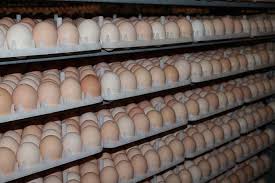Effects of Short Periods of Incubation During Egg Storage (SPIDES) in Prolonged Stored Eggs of Late DeKalb Breeder on Hatchability, Embryonic Mortality and Chick Quality
Abstract
The objective of this study was to study the effects of short periods of incubation during egg storage (SPIDES) of late DeKalb breeder, age and storage period on the hatchability, embryo mortality and chick quality. A total of 810 fertile eggs were randomly selected and allocated into three groups (270 eggs each). Each group was distributed in a 3 x 3 x 3 factorial experiment in a complete randomized design with three warming treatments (0, 60 and 120 minutes daily at 37.5○ C and 53% RH), age (75, 80, and 85 weeks) and three storage periods (4, 9 and 14 days 18○ C and 75%). Each treatment was replicated three times with ten eggs each. Fertility and hatchability of both fertile and total eggs were determined. Embryo mortality was determined in non-hatched eggs. All hatched chicks were weighed and graded to first or second grade chick. Results indicated that SPIDES for 60 minutes significantly improved the hatchability, reduced early dead embryos and total unhatched eggs and chick quality as compared to non-heated eggs or SPIDES for 120 minutes. The obtained results indicated that the daily SPIDES for 60 minutes significantly (P ≤ 0.01) reduced embryonic mortality during the three incubation periods. The lower embryonic mortality was observed for 75 week old breeders and for eggs stored for 4 days. Moreover, SPIDES eggs for 60 minutes significantly (P ≤ 0.01) improved hatchability and chick quality percentages. Also the best hatchability and chick quality percentages were observed for the breeder of 75 week of age. Eggs stored for 4 days reported the best hatchability and chick quality percentages. In conclusion, daily SPIDES of late DeKalb breeder hatching eggs for 60 minutes at 37.5° C and 53% RH could be used by the poultry industry as a method to improve hatchability and increased the number of saleable first grade chicks which by far increases profits of eggs stored for longer periods.
Downloads
References
Bakst M. R. Welch, G. R. Fetterer, R. and Miska, K. (2016). Impact of broiler egg storage on the relative expression of selected blastoderm genes associated with apoptosis, oxidative stress, and fatty acid metabolism. Poult. Sci., 95:1411–1417.
Christensen, V. L., Wineland, M. J., Fasenko, G. M. and Donaldson, W. E. (2001). Egg storage effects on plasma glucose and supply and demand tissue glycogen concentrations of broiler embryos. Poult. Sci., 80:1729–1735.
Damaziak, K., Paweska, M., Gozdowski, D. and Niemiec, J. (2018). Short periods of incubation, egg turning during storage and broiler breeder hens age for early development of embryos, hatching results, chicks quality and juvenile growth. Poultry Science, 97:3264-3276.
Dymond, J., Vinyard, B., Nicholson, A. D., French, N. A. and. Bakst, M. R. (2013). Short periods of incubation during egg storage increase hatchability and chick quality in long-stored broiler eggs. Poult. Sci. 92:2977–2987.
Elibol, O., Peak, S. D. and Brake, J. (2002). Effect of flock age, length of egg storage and frequency of turning during storage on hatchability of broiler hatching eggs. Poult. Sci., 81:945–950.
Erensayin, C. (2000). Scientific Technical Practical Poultry Broiler breeding and hatchability. Nobel Publication. Ankra, Turkey in Turkish English abstract. Vol.1.2nd rev.ed.
Fasenko, G. M., Hardin, R. T. and Robinson. F. E. (1992). Relationship of hen age and egg sequence position with fertility, hatchability, viability, and pre incubation embryonic development in broiler breeders. Poult. Sci. 71:1374–1383.
Fasenko, G. M., Robinson, F. E., Whelan, A. I., Kremeniuk, K. M. and Walker, J. A. (2001a). Pre storage incubation of long-term stored broiler breeder eggs: 1. Effects on hatchability. Poult. Sci., 80:1406–1411.
Fasenko, G. M., Christensen, V. L. Wineland, M. J. and Pettite, J. N. (2001b). Examining the effects of pre storage incubation of turkey breeder eggs on embryonic development and hatchability of eggs stored for four or fourteen days. Poult. Sci., 80:132–138.
Fasenko, G. M. (2007). Egg storage and the embryo. Poult. Sci., 86 (5), 1020-1024.
Fasenko, G. M. and O’Dea, E E. (2009). Evaluating broiler growth and mortality in chicks with minor level conditions at hatching. Poult. Sci., 87: 594 -597.
Gharib H.B. (2013). Effect of pre-storage heating of broiler breeder eggs, stored for long periods, on hatchability and chick quality. Egyptian J. Anim.Prod. 50 (3):174 -184.
Hamidu, J. A., Rieger, A. M., Fasenko, G. M. and Barreda, D. R. (2010). Dissociation of chicken blastoderm for examination of apoptosisand necrosis by flow cytometry. Poult. Sci. 89:901–909.
Hamidu, J. A., Uddin, Z., Li, M., Fasenko, G. M., Guan, L. L. and Barreda. D. R. (2011). Broiler egg storage induces cell death andinfluences embryo quality. Poult. Sci. 90:1749–1757.
Petek, M. and Dikmen, S. (2004). The effects of prestorage incubation of quail breeder eggs on hatchability and subsequent growth performance of progeny. Animal. Research, 53: 527–534.
Petek, M. and Dikmen, S. (2006). The effect of pre storage incubation and length of storage of broiler breeder eggs on hatchability and subsequent growth performance of progeny. Czech J.Sci., Vol.51,(2):73-77.
Reijrink I. A. M., Meijerhof, R., Kemp, B. and van den Brand, H. (2008). The chicken embryo and its micro environment during egg storage and early incubation. World’s Poultry Science Journal. 64:581-598.
Reijrink , I. A. , Berghmans, D., Meijerhof, R., Kemp, B. and van den Brand, H. (2010). Influence of egg storage time and pre incubation warming profile on embryonic development, hatchability, and chick quality. Poult. Sci., 89:1225–1238.
Reijrink, I. A. M., Meijerhof, R., Kemp, B., Graat, E. A. M. and Van den Brand, H. (2009). Influence of pre storage incubation on Embryonic Development, Hatchability, and chick quality. Poult. Sci., 88: 2649–2660
Ruiz, J. and Lunam, C.A. (2002). Effect of pre-incubation storage conditions on hatchability, chick weight at hatch and hatching time in broiler breeders. British poultry science, 43:374-383.
SPSS (2008). Statistical package for the social sciences, version 17.0. Chicago: SPSS Inc,.
Steel, R. G. D., Torrie, G. H. and Dickey, D. A. (1996). Principles and Procedures of Statistics: A Biometrical Approach, 3rd ed., p. 666.McGraw Hill Book Comp. Inc. New York
Tag EL–Din, T. H., Kalaba, Z. M., EL-Kholy, K. H. M .and Abd-EL-Maksoud, S. A. (2017). Effect of short period incubation during egg storage on hatchability, embryonic mortality and chick quality. J. Anim. and Poultry Prod., 8 (7): 161 – 165.
Tona K, Bamelis F, De Ketelaere B, Bruggeman, V. Moraes VMB, Buyse J, Onagbesan O, and Decuypere E (2003). Effects of egg storage time on spread of hatch, chick quality, and chick juvenile growth. Poult. Sci. 82:736–741.
Tona K, Onagbesan O, DeKetelaere B, Decuypere E, Bruggeman V (2004). Effects of age of broiler breeders and egg storage on egg quality, hatchability, chick quality, chick weight, and post-hatch growth to forty-two days. Journal of Applied Poultry Research (13):10–18.
Van De Van, L. (2004). Storage of hatching eggs in the production process," International Hatchery Practice, vol. 18, pp. 27–31.
Yassin, H., A., Velthuis, G. J., Boerjan, M., Van Riel, J. and Huirne, R. B. M. (2008). Field study on broiler eggs hatchability. Poult. Sci., 87:2408–2417.











